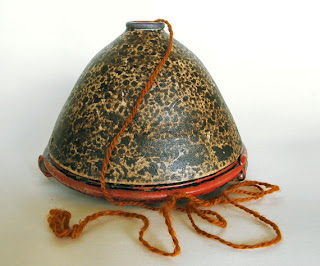After reading Ang's design blog about Obvara firing I wondered what it was. Ang has a video on her blog about Obvara firing. After researching all about Obvara I wished I had my raku kiln here with me. You know I'd be trying it right away. Working with clay is fun. Even with all the mistakes and failures it's the fun and the experimentation that keeps me sticking with clay. The yarn bell above was made by Cathi Newlin and is available on Etsy.
I researched on the net and learned Obvara Pottery has it's roots in Eastern Europe from the 19th century Belarussian. It's a technique of firing pots and then scalding them to seal their surface. Through the process some interesting surfaces are achieved. Kelsey Schroeder has a wonderful pictorial on her facebook page showing how Obvara pottery is made. The pot above was made by Kelsey.
I'm loving the earthy surfaces this technique achieves and it reminds me of sepia tone photography. Above is a photograph I took of a blue heron in Florida and I have applied the sepia tone technique to the photo. Sepia tone brings a soft and nostalgic look to contrasting objects in photos.
Here is the original photograph without the sepia tone applied.
Pots fired using the Obvara technique should have the ability to take thermal shock so raku clay or a clay with a fair amount of grog should be used. The pots should be bisque fired. Meanwhile the Obvara mixture should be made. In a five gallon bucket mix 2.6 gallons of warm water with 2.2 pounds of flour, one tablespoon of sugar and 2 packets of yeast. Allow the mixture to ferment for about three days stirring frequently. The calla lily pots above were made by Gail Scuderi.
Then fire the pots again to about 1650 to 1750. Remove pot from kiln with raku tongues and plunge it into the Obvara mixture and swirl it around in there. Next plunge the pot into a five gallon bucket of water and swirl it around in there. Keep the tongues on the pot and don't let go in either the Obvara or water. Set the pot aside to cool. The goose above was made by Janice Chassier. She said the pots come out smelling like pizza or burnt toast. Ha. All I need is a new studio to try this technique out, hopefully sooner than later. Today I am missing clay; can you tell? this post is part of Mud Colony what's happening in the studio. Thanks for reading and for all your comments.







I also was so inspired by ang's Obvara post and THANK YOU for doing so much research and putting together such a comprehensive post. The pots you chose for illustration are lovely, and while I haven't gone so far as to price burners, I'm close....
ReplyDeleteThanks for the information about the Obvara technique, it looks very interesting, and I love the goose done that way (a goose smelling like pizza, what next!!!).
ReplyDeleteI also had to look up Obvara after reading that post. Really interesting.
ReplyDeleteI had never heard of obvara either, interesting techniqe.
ReplyDeleteHi Christine, thanks, oh I do love these surfaces on the pots, cant' wait to try it.
ReplyDeleteHi Peter, thanks, yes well I am assuming the smell goes away after a bit of time I hope.
Hi Melissa, thanks, I just love the surfaces of the pots, they almost look like crystals but then again maybe ink spots.
Hi Michele, thanks, when I saw the surfaces I was thinking your pigs would be great done this way.
Thank you for the links - it is a fascinating technique with amazing results.
ReplyDeleteHi Elephant's Child, thanks, who knew what could come of some flour sugar and yeast on pottery. Ha.
ReplyDeleteOh No! Now there is another technique to learn. Thanks for an informative and interesting post....with heron!
ReplyDeleteInteresting post and link. Thanks, Linda for such a good read. The surface looks like my drying gourds! Which I love, btw.
ReplyDeleteReally interesting post, thank you. :) I had never heard of this technique .. in fact never come across one using flour! Fascinating, and the surfaces are very nice, I especially like the vase in the second photo.
ReplyDeleteHi Suzi, thanks, it's endless isn't it?
ReplyDeleteHi Charlene, thanks, oh I do love a good gourd.
Hi Mark, thanks, it's really amazing what can be done with clay, I love the mottled surfaces of them all.
had never heard of obvara finding. life is just full of learning--- what a post full of lots in it! thanks, Linda.
ReplyDeleteI am missing your clay too. :)
ReplyDeleteThat does look like fun.
ReplyDeleteMany many thanks for this post. I saw some pots fired using obvara technique in Lithuania. They were really interesting.
ReplyDeleteI think, I'll try this in autumn ;)
Thank you very much for this interesting post. I saw some pots fired using obvara technique in Lithuania, they were really interesting. I think, I'll try this in autumn ;)
ReplyDeleteHi Amy, thanks, I can't wait to try this technique as soon as I settle down.
ReplyDeleteHi Dee, thanks, soon I hope, soon.
Hi Lori, thanks, oh I do like the surfaces achieved.
Hi Llona Jo, thanks, oh it does look like a fun technique to try, good luck with your firing.
Thanks for the info. My friend and I are going to try this out next month. I cannot wait!
ReplyDelete